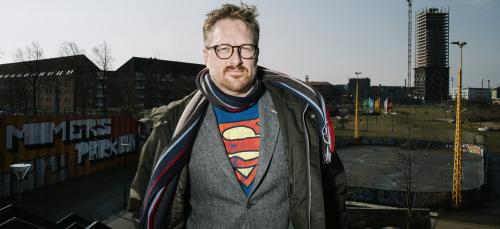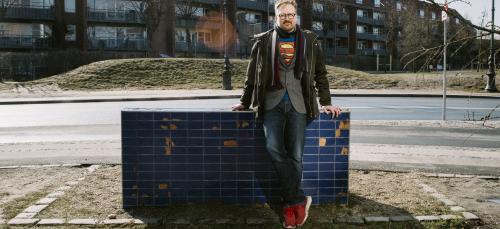Flawed ghetto policy focuses on areas rather than people

Tear it down. These were the words of Prime Minister Lars L?kke Rasmussen in his New Year speech on 1 January. Ever since, there has been heated debate about the ghettos in Denmark in the wake of the government's ghetto list and subsequent ghetto proposals, which they presented in March.
However, the entire basis for the government's ghetto proposal is problematic, according to housing researcher and associate professor at Roskilde University, Troels Schultz Larsen:
"The fundamental problem with the ghetto list is that it does not solve the problem, because it focuses on neighbourhoods rather than people. It does not tackle the structural problems that exist in relation to the labour market, the housing market and poverty. Instead, the list produces stigmatization, makes people feel unsafe and is directly counter-productive, because it changes both the residents’ and everyone else's perception of the area and those who live there" says Troels Schultz Larsen, associate professor at the Department of Social Sciences and Business.
Inspiration from other countries
Troels Schultz Larsen says that when politicians, urban planners and even other researchers are required to come up with solutions to the problems in the neglected housing estates, it is common to seek inspiration in other countries. Study trips are taken to Paris. They look at what has been done in Holland. This often occurs without taking account of the major differences that can exist between countries.
In a new scientific article published in Urban Geography, Troels Schultz Larsen systematically reviews the pitfalls that exist when trying to compare neglected housing estates in France and Denmark and transfer experiences directly from one country to the other. Among other things, the buildings in France's ghettos are generally in much poorer condition than in Denmark. The labour market and the housing market are also different, and social housing efforts are much more centralised in France.
"It makes good sense to learn from the experiences of France, the United States or Holland. But the demolition proposal, for example, is largely based on foreign experience, and there could be more nuances here. My mission is that we should not rely on foreign experience that does not make sense in Denmark. There are also a number of different factors that must be taken into account” explains Troels Schultz.
"There is a tendency to assume that because the symptoms are largely the same, the disease is also the same. But we have to be careful about transferring the diagnosis from one community to another” says Troels Schultz Larsen.
Problems with demolition and rehousing
Troels Schultz Larsen consistently refers to what the government calls 'ghettos' as ‘neglected housing estates’. He believes that the word ghetto is problematic in a Danish context, because we simply do not have ghettos in Denmark. He points out, however, that this is not the same as saying that we do not have social problems and housing problems.
"We do not have ghettos in Denmark"
The research-based definition of ghettos used by Troels Schultz Larsen is developed by tt备用网址 Lo?c Wacquant, UC Berkely/Paris:
- One homogeneous, stigmatized population group (e.g. Jews and blacks).
- Physical demarcation. In other words, physically and/or socially separated from the rest of the surrounding community with a clear demarcation of inside/outside.
- Economic constraints. Direct and indirect discrimination, for example in the labour market, based on characteristics of the area in which one lives.
- Institutional demarcation. The ghettos are largely cut off from the community's public institutions and they therefore develop their own institutions.
- Territorial stigmatization characterized by a shaming of certain places.
According to Troels Schultz Larsen, it is an absurdity to talk about ghettos or parallel societies in Denmark. For example, this does not concern a homogeneous population group, and several areas have residents from up to 60 different countries. Similarly, the high relocation rates show that there are no fixed boundaries between these areas and the surrounding community. In Denmark, the public sector is also intensely present in the neglected housing estates with day-care centres, public schools, out-reach and community
One of the key features of the government's ghetto proposal is the demolition of large parts of the ghettos, and this plan is problematic for several reasons, he argues. As a consequence of the government's ghetto plan, up to 11,000 households may have to be rehoused. Troels Schultz Larsen points out that there are a large number of e.g. legal, economic and planning challenges associated with the rehousing.
"It would greatly affect the municipalities’ economy. There are no resources for the municipalities to tackle this problem, and 11,000 family homes cannot simply be conjured up", he explains and continues:
"There will be an extremely large rehousing requirement, and it is difficult to see how the municipalities would be able to solve this within the ordinary legislation and the general municipal framework. This could be a very difficult situation for the municipalities.”
Long-term efforts
Troels Schultz Larsen believes that one should focus instead on the long-term efforts in the neglected housing estates and look at the people who live there, instead of where they live. Today, one is largely blind to the processes that take place across the neighbourhoods and the surrounding cities, the researcher points out:
"Many people move out of the neglected housing estates when, for example, they are able to afford to buy a property. This means that people move in and out of these areas, so it is completely wrong to assume that there is no development or change. In some areas, up to 25% of the residents move each year, and this means in principle that large parts of the residents may be replaced after four years, even though some of the problems remain the same. We must take an interest in the processes that occur with the people who live there over time" says the housing researcher.

Troels Schultz Larsen also explains that in Denmark, we tend to arrange our social housing work in projects that span relatively short periods, and he believes that politicians should be prepared to be more patient in this regard:
"Experience shows that we will need 20-25 years if we want to see the effects of our efforts. Naturally, we must make an effort. We should not just sit back and think that everything will be alright. But it is the difficult, long-term efforts that work” says Troels Schultz Larsen and illustrates the point with a specific example that shows that long-term investment is required in order to be able to handle e.g. emergency situations in the neglected housing estates:
"There was a shooting in one of these neighbourhoods a few years ago. Two hours later, a number of the social housing workers from the area had gathered all the children from the estate and given them a debriefing and psychological support. This requires a strong network, trust and knowledge about what is occurring. This shows that it is an enormous success. They gathered the children and dispelled the insecurity. But they also talked about what had actually happened and told the children that this is not a path they should follow.”
Troels Schultz Larsen is an associate professor at the Department of Social Sciences and Business.
Published in Rubrik #13, 2018
Facts:
About the government's ghetto proposal:
The government launched its new ghetto proposal on 1 March: ‘One Denmark without parallel society - no ghettos in 2030’. According to the government, the new initiative will tackle the parallel society and DKK 12 billion will be earmarked for demolition and conversion of vulnerable neighbourhoods from 2019 to 2026.
The mentioned scientific article:
Schultz Larsen, Troels (2018). 'Advanced Marginality as a comparative research strategy in praxis: the Danish “Grey Belt” in conversation with the French “Red Belt”', Urban Geography, ahead of print.